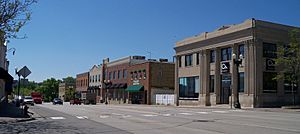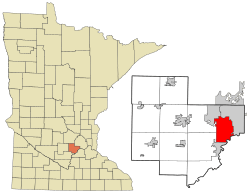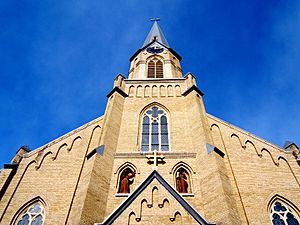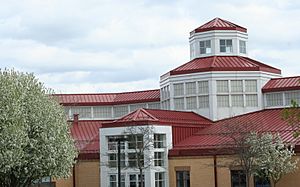Chaska, Minnesota facts for kids
Quick facts for kids
Chaska
|
|
|---|---|

Buildings in downtown Chaska
|
|
| Motto(s):
"A Quality Small Town"
|
|

Location in Carver County, Minnesota
|
|
| Country | United States |
| State | Minnesota |
| County | Carver |
| Incorporated (village) | 1871 |
| Incorporated (city) | 1891 |
| Area | |
| • Total | 17.84 sq mi (46.20 km2) |
| • Land | 17.02 sq mi (44.09 km2) |
| • Water | 0.81 sq mi (2.11 km2) |
| Elevation | 919 ft (280 m) |
| Population
(2020)
|
|
| • Total | 27,810 |
| • Estimate
(2022)
|
28,262 |
| • Density | 1,633.48/sq mi (630.70/km2) |
| Time zone | UTC-6 (Central) |
| • Summer (DST) | UTC-5 (CDT) |
| ZIP Code |
55318
|
| Area code(s) | 952 |
| FIPS code | 27-10972 |
| GNIS feature ID | 2393809 |
Chaska (pronounced CHASS-kuh) is a city in Minnesota, United States. It is the main city, or county seat, of Carver County. In 2020, about 27,810 people lived there.
Chaska is a suburb located just outside the Twin Cities area. It is famous for the Hazeltine National Golf Club. The city also has a beautiful historic downtown area right by the Minnesota River. In 2006, the City of Chaska joined with Chaska Township. Even today, you can still find some farms and agricultural land in the city.
Contents
History of Chaska
The history of Chaska shows the strong influence of Native American culture. The very first people to live here were likely the Mound Builders. You can still see their ancient communities marked by mounds in City Square. Later, the Dakota people, also known as the Sioux, were the main group in this area. This region was known as the Big Woods.
Chaska's recorded history began in 1769. However, the Indian mounds in City Square show that people lived here many years before that. In 1776, Jonathan Carver explored the lands along the Minnesota River. He wrote down what he saw and experienced on his journeys.
French Canadian fur traders traveled the rivers in the early 1800s. They traded goods with the Dakota people. During this time, Jean-Baptiste Faribault set up a trading post in Chaska.
In 1851, the Treaty of Traverse des Sioux was signed. This treaty officially opened the area, then called Little Rapids, for new settlers. Soon after, people looking for land moved into this new territory. One of the first was Thomas Andrew Holmes. In August 1851, he claimed a 20-acre clearing as the Chaska townsite.
The name "Chaska" comes from a Dakota word. It was often given as a name to the first-born male child. Records show that David L. Fuller bought the "Shaska" townsite from Holmes in 1852. In 1857, the townsite was officially mapped out by the Shaska Company. That same year, construction began on the first Carver County Courthouse.
Chaska became an official village in 1871. Then, by a special law, it became a city in 1891.
The area had a lot of high-quality clay. This led to brick making starting in 1857. By the 1880s, Chaska was a busy center for making bricks. Bricks were sent by boat to Saint Paul. The city grew because of steamboat trade. But it really started to grow fast after the Minneapolis and St. Louis Railway was built through town in 1873.
As the 1900s began, other industries came to Chaska. These included processing beet sugar and other farm products. They also made flour and butter. People canned peas, corn, and tomatoes. They also made sauerkraut and pickles.
Chaska has been recognized as a great place to live. National polls named it the eighth-best city in the U.S. in 2007. It was also ranked 20th best in 2009.
In September 2016, Chaska hosted the Ryder Cup. This big golf event took place at Hazeltine National Golf Course. In 2018, it was announced that Hazeltine would host the Ryder Cup again in 2028. This will be the first time an American golf course hosts the event twice.
Geography of Chaska
Chaska covers a total area of about 17.77 square miles (46.02 square kilometers). About 16.97 square miles (43.95 square kilometers) is land. The other 0.80 square miles (2.07 square kilometers) is water. The downtown part of Chaska is located right on the Minnesota River.
Some of the main roads in Chaska include:
- Chaska Boulevard (Old Highway 212)
- Pioneer Trail
- U.S. Highway 212
- Minnesota State Highway 41
| Climate data for Chaska, Minnesota | |||||||||||||
|---|---|---|---|---|---|---|---|---|---|---|---|---|---|
| Month | Jan | Feb | Mar | Apr | May | Jun | Jul | Aug | Sep | Oct | Nov | Dec | Year |
| Mean daily maximum °F (°C) | 22 (−6) |
28 (−2) |
40 (4) |
57 (14) |
69 (21) |
78 (26) |
81 (27) |
78 (26) |
71 (22) |
58 (14) |
41 (5) |
26 (−3) |
54 (12) |
| Mean daily minimum °F (°C) | 4 (−16) |
9 (−13) |
21 (−6) |
34 (1) |
46 (8) |
56 (13) |
60 (16) |
58 (14) |
49 (9) |
36 (2) |
23 (−5) |
8 (−13) |
34 (1) |
| Average precipitation inches (mm) | .73 (19) |
.66 (17) |
1.73 (44) |
2.53 (64) |
3.69 (94) |
4.64 (118) |
3.49 (89) |
5.05 (128) |
3.41 (87) |
2.47 (63) |
1.64 (42) |
.95 (24) |
30.99 (789) |
| Source: The Weather Channel | |||||||||||||
People in Chaska
| Historical population | |||
|---|---|---|---|
| Census | Pop. | %± | |
| 1880 | 1,068 | — | |
| 1890 | 2,210 | 106.9% | |
| 1900 | 2,165 | −2.0% | |
| 1910 | 2,050 | −5.3% | |
| 1920 | 1,966 | −4.1% | |
| 1930 | 1,901 | −3.3% | |
| 1940 | 1,927 | 1.4% | |
| 1950 | 2,008 | 4.2% | |
| 1960 | 2,501 | 24.6% | |
| 1970 | 4,352 | 74.0% | |
| 1980 | 8,346 | 91.8% | |
| 1990 | 11,339 | 35.9% | |
| 2000 | 17,449 | 53.9% | |
| 2010 | 23,770 | 36.2% | |
| 2020 | 27,810 | 17.0% | |
| 2022 (est.) | 28,262 | 18.9% | |
| U.S. Decennial Census 2020 Census |
|||
For the first half of the 1900s, Chaska's population stayed around 2,000 people. It kept its small-town feel. But in the 1950s, it started to become more like a big city. The growth of the larger metropolitan area reached Chaska in the 1960s.
This growth brought a new idea called the Jonathan New Town design concept in 1966. This plan helped bring new land, jobs, and people to Chaska.
Chaska continues to grow and change today. Many modern businesses have moved to Chaska. New homes are built each year. Shops and services are also expanding. The downtown area has been updated since the 1980s. Even with all this growth, Chaska has worked to keep its small-town community feel. It also tries to protect its rich history.
In 2005, the city of Chaska took over the rest of Chaska Township. There are plans to build a new neighborhood there. It will be a "smart growth" community on 600 acres.
The population grew even more after Highway 212 was built. This freeway goes right through Chaska. It offers a fast way to get to the heart of the Twin Cities. The freeway also has a bus rapid transit route. This gives Chaska residents quick public transportation. It also connects them to the Light Rail system.
As of the census in 2020, there were 27,810 people living in Chaska. There were 10,336 households.
Economy and Jobs
Chaska is home to many different businesses and factories. Some of these include TPI Specialties, Update Ltd, Wigen Water Technologies, Beckman Coulter, and Hartman Homes.
Over the years, several well-known products and companies started in Chaska. These include Softsoap, NordicTrack, and Heartland America.
The Chaska Curling Center opened in December 2015. It has become a very important place in the city. The Center helps people in Chaska get involved in the community. It also helps businesses downtown. It has even brought national and international attention to the city.
In 2016, the Norwegian and American Olympic curling teams played a special game there. This was to celebrate the start of the Ryder Cup golf tournament in Chaska. In 2018, the Chaska Curling Center was named a USA Curling National Training Center. This means it can host national events and be used for training by the U.S. Curling team.
Top Employers in Chaska
Here are some of the biggest employers in Chaska, based on a 2020 report:
| # | Employer | # of Employees |
|---|---|---|
| 1 | Eastern Carver County Schools (ISD #112) | 1,346 |
| 2 | Entegris Inc | 925 |
| 3 | Beckman-Coulter, Inc | 850 |
| 4 | TEL-FSI, Inc | 850 |
| 5 | Carver County | 700 |
| 6 | The Bernard Group | 646 |
| 7 | Lake Region Manufacturing Co., Inc | 600 |
| 8 | Old National Bank | 560 |
| 9 | City of Chaska | 535 |
| 10 | Apex International, MFG | 400 |
Education in Chaska
Children in Chaska go to schools in the Eastern Carver County School District. This district used to be called District 112. The name changed when the district grew.
Elementary schools in Chaska include:
- Clover Ridge Elementary
- Jonathan Elementary
- La Academia Spanish Immersion
The middle schools for District 112 are all in Chaska:
- Chaska Middle School East
- Chaska Middle School West
- Pioneer Ridge Middle School
The district has two high schools:
- Chaska High School
- Chanhassen High School
There is also a private high school in Chaska called Southwest Christian High School. Several private elementary schools are also in town. These include St. John's Lutheran Church and School, and Guardian Angels Catholic School.
Famous People from Chaska
Many notable people have connections to Chaska:
- Phillip Bartlett – an actor, known as the voice of Mewtwo in the first Pokémon movie.
- Andy Bisek – an American Greco-Roman wrestler and Olympian.
- Greg Boe – a representative in the Minnesota House of Representatives.
- Tony Denman – an actor.
- Ryan Dungey – a professional motocross rider.
- Brad Hand – an MLB pitcher for the Philadelphia Phillies.
- Kris Humphries – an NBA power forward.
- Jeff Isaacson – a two-time Gold medal American Olympic curler.
- Charles H. Klein – a Minnesota state legislator and businessman.
- Jerry Koosman – an MLB pitcher and two-time All-Star for the New York Mets.
- Mike Lindell – founder of My Pillow.
- Howard G. Ottinger – a businessman, farmer, and Minnesota state legislator.
- Gordon Paschka – a former NFL player.
- Erik Paulsen – a United States Congressman.
- Mike Reilly – a defenseman for the New York Islanders.
- Howie Schultz – an MLB first baseman for the Brooklyn Dodgers.
- Dave Snuggerud – a former NHL player and 1988 Olympian.
- Edward Van Sloan – an actor and artist.
- Stephen Wolff – a comedian and public servant.
See also
 In Spanish: Chaska (Minnesota) para niños
In Spanish: Chaska (Minnesota) para niños



